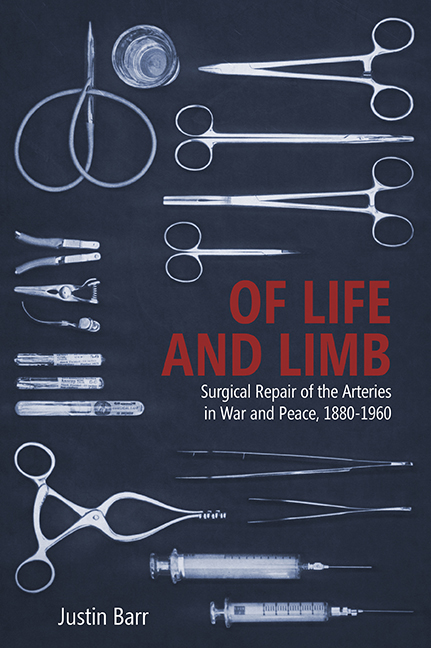 Surgical Repair of the Arteries in War and Peace, 1880–1960
Surgical Repair of the Arteries in War and Peace, 1880–1960 Book contents
- Frontmatter
- Contents
- Acknowledgments
- Introduction
- 1 Technical Change, Practical Stasis: The Development of Arterial Repair through 1914
- 2 An Ideal Rarely Practiced: Arterial Repair and Its Alternatives from World War I to World War II
- 3 Opportunities Realized and Discarded: The Management of Vascular Trauma in World War II
- 4 Reshaping Surgical Infrastructure between World War II and the Korean War
- 5 An Ideal Implemented: Arterial Repair in the Korean War
- 6 Bringing It All Back Home
- Conclusion: Arterial Repair and the Process of Surgical Change
- Notes
- Bibliography
- Index
3 - Opportunities Realized and Discarded: The Management of Vascular Trauma in World War II
Published online by Cambridge University Press: 29 March 2020
- Frontmatter
- Contents
- Acknowledgments
- Introduction
- 1 Technical Change, Practical Stasis: The Development of Arterial Repair through 1914
- 2 An Ideal Rarely Practiced: Arterial Repair and Its Alternatives from World War I to World War II
- 3 Opportunities Realized and Discarded: The Management of Vascular Trauma in World War II
- 4 Reshaping Surgical Infrastructure between World War II and the Korean War
- 5 An Ideal Implemented: Arterial Repair in the Korean War
- 6 Bringing It All Back Home
- Conclusion: Arterial Repair and the Process of Surgical Change
- Notes
- Bibliography
- Index
Summary
In World War II, only 1 percent of all wounds among American soldiers directly afflicted the vascular system, but these injuries caused a disproportionate 20 percent of amputations. Given these severe consequences, trauma to major arteries attracted extensive medical attention before, during, and after the conflict. Even more than the First World War, the Second World War offered surgeons opportunities to repair vessels and not just ligate them, providing them the chance to preserve arms and legs. Better-trained surgeons worked in conditions markedly improved from the trenches of World War I while retaining extraordinary autonomy of practice and freedom from regulatory oversight. Major battles continued to create thousands of bleeding patients in desperate need of vascular surgery. Medical advances like heparin, arteriograms, and sulfa antibiotics in the interbellum years as well as penicillin and blood transfusion early in the war promised greater success and started to alter both physician and patient expectations: whereas before saving lives was the priority, the conditions of the Second World War made it possible for doctors to focus on life and limb.
Despite these developments, the American military medical leadership entered World War II strongly recommending ligation and sympathectomy for vascular trauma. They believed the speed, simplicity, and effectiveness of this combination therapy superseded any potential benefits of anastomosis. Once again, high rates of amputation proved this prescription wrong. By the end of the war, the prodigious loss of limbs prompted a previously undescribed shift from ligating to repairing arterial injuries on both the front lines and in army hospitals in the United States. Surgeons who had transformed their practice saved the arms and legs of hundreds of Americans, foreshadowing future care. However, when leaders in American surgery wrote several seminal articles downplaying the transition to repairing arteries and its role in military medicine, the therapy faded from use. Only after hundreds of additional amputations during the Korean War did doctors return to arterial repair as the preferred practice, poignantly demonstrating the power of memory and history in shaping the care of patients.
Creating Opportunities for Arterial Repair: Military Medicine in World War II
Military medicine in World War II built on the experiences of the Great War as well as developments in the interwar period to minister to the millions of soldiers, sailors, airmen, marines, and civilians affected by the conflict.
- Type
- Chapter
- Information
- Surgical Repair of the Arteries in War and Peace, 1880–1960Surgical Repair of the Arteries in War and Peace, 1880–1960, pp. 66 - 91Publisher: Boydell & BrewerPrint publication year: 2019


